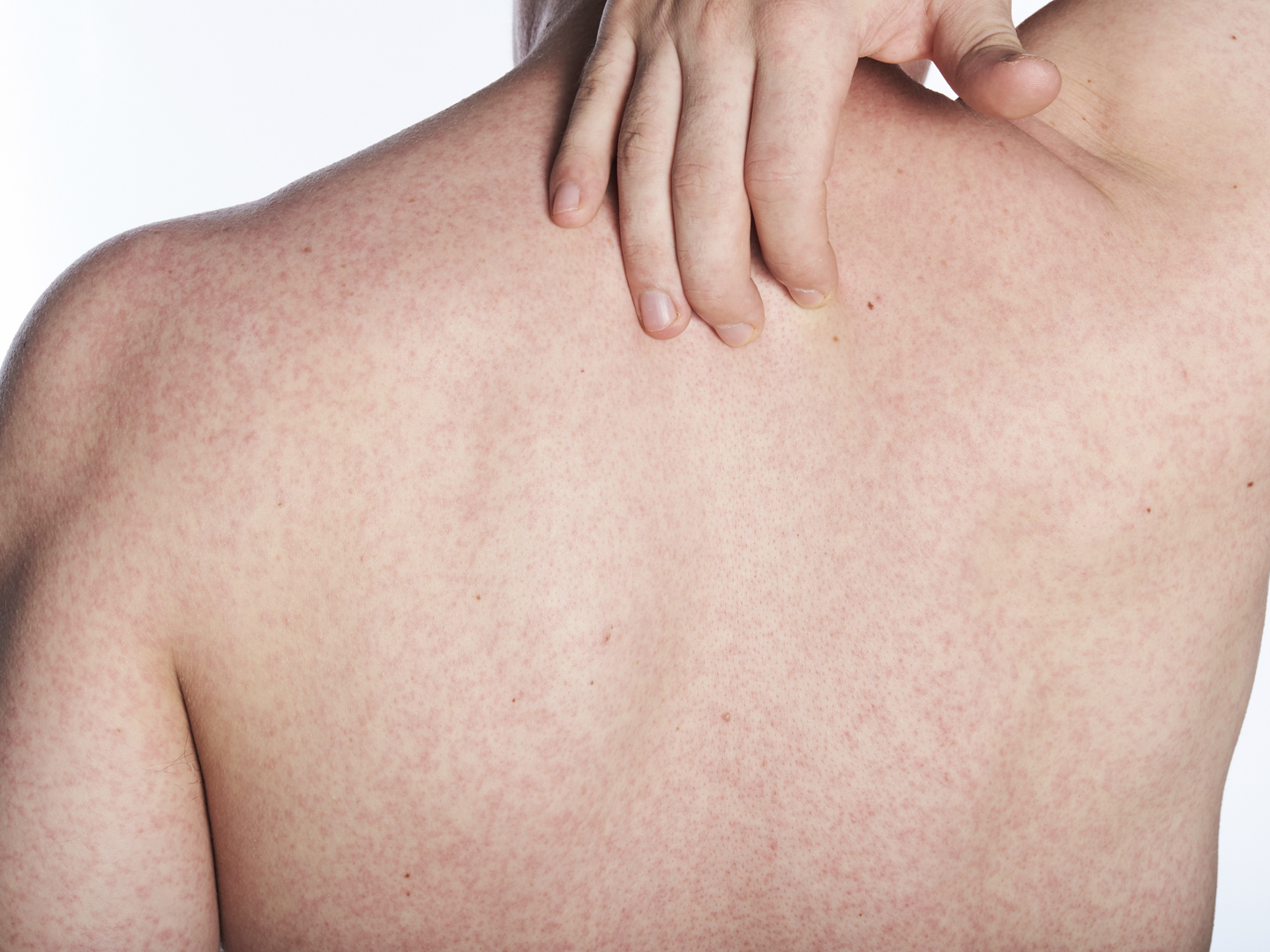Scarlet fever (also known as scarlatina in older literature references) is a syndrome characterized by a blanching, erythematous, maculopapular rash often described as “sandpaper-like,” a “strawberry tongue,” and exudative pharyngitis. The causative organism, Streptococcus pyogenes (group A Streptococcus or “GAS”), is a gram-positive bacterium adapted to humans. This organism grows in pairs and chains and is responsible for a range of infections, including superficial, deep, and invasive conditions such as cellulitis, pharyngitis, erysipelas, and necrotizing fasciitis.
This condition (scarlet fever or scarlatina) is characterized by a blanching, erythematous, maculopapular rash, often described as “sandpaper-like,” a sore throat, “strawberry tongue,” and exudative pharyngitis. Scarlet fever primarily affects children and often accompanies GAS pharyngitis, although it may also arise from other Streptococcus pyogenes (group A Streptococcus or “GAS”) infections. Scarlet fever is caused by streptococcal pyrogenic exotoxins—a type of superantigen produced by Streptococcus pyogenes (group A Streptococcus or “GAS”).
GAS produces streptococcal pyrogenic exotoxins (SPEs), which act as superantigens released during infection. These exotoxins are the primary cause of the erythematous rash associated with scarlet fever.
GAS bacterial pharyngitis and scarlet fever most commonly affect school-age and adolescent children due to higher transmissibility in school settings. However, these infections can also occur in other age groups, particularly in crowded environments such as households and nursing homes.
Physical examination, Sign & Symptoms
Patients may seek medical attention for complaints such as pharyngitis or cellulitis without initially noticing the rash. Scarlet fever is most commonly associated with acute pharyngitis caused by GAS but may also result from other GAS infections, such as erysipelas or wound infections. The incubation period for GAS ranges from 1 to 5 days. The characteristic rash of scarlet fever typically appears 24 to 48 hours after the onset of initial symptoms, most commonly GAS pharyngitis. 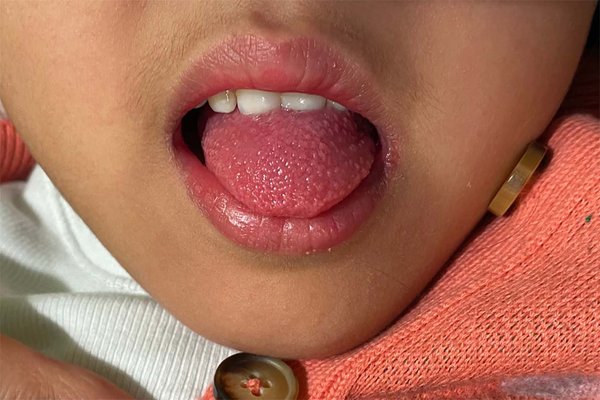
The most common symptoms of group A Streptococcus or “GAS” pharyngitis include a sudden onset of fever and sore throat. Additional complaints may include headache, nausea, chills, vomiting, and abdominal pain.
When taking a patient’s history, it is common to note exposure to close contact with a GAS infection, particularly if the individual is a school-age child or someone residing in a community setting, such as a nursing home, where close living conditions can increase the risk of transmission. On examination, physical findings of GAS pharyngitis typically include generalized inflammation of the tonsils and pharynx, variable tonsillar exudates, a red and swollen uvula, and palatal petechiae. Tender cervical lymphadenopathy is also commonly noted on palpation.
Viral infection
Conjunctivitis, cough, coryza, emesis, or diarrhea may be present, and their presence typically suggests a viral etiology rather than GAS. Physical examination of the posterior oropharynx alone is generally insufficient to differentiate GAS from other causes of acute pharyngitis, such as viral pharyngitis, which is the most common type. While the Centor Criteria were developed to aid in diagnosing GAS pharyngitis based on clinical findings, they are not reliable as a standalone tool and should be supplemented with microbiological testing for accurate diagnosis.
Skin signs
A thorough skin examination is essential, as a fine, blanching, maculopapular erythematous rash accompanied by a strawberry tongue strongly suggests scarlet fever. The rash associated with scarlet fever typically appears 2 to 3 days after the onset of infection but can be delayed for up to 7 days. The rashes generally begin on the trunk, underarms, and groin, spreading to the extremities while sparing the palms and soles. The area around the mouth remains pale, creating a distinctive “circumoral pallor.” A characteristic strawberry tongue develops, initially presenting with a white membrane on the tongue and enlarged, protruding papillae, referred to as a “white strawberry tongue.”
As the membrane sloughs off, the papillae persist, giving the tongue a red, strawberry-like appearance. Pastia lines are linear clusters of papules observed in skin folds or pressure points, such as the neck, antecubital fossa, and groin. After the initial rash subsides, a phase of skin desquamation may occur, sometimes lasting up to 2 weeks.
Other symptoms
The patient usually appears moderately ill. Fever may be present. The patient may have tachycardia. Tender anterior cervical lymphadenopathy may be present. The mucous membranes usually are bright red, and scattered petechiae and small red papular lesions on the soft palate are often present.
On day 1 or 2, the tongue is heavily coated with a white membrane through which edematous red papillae protrude (classic appearance of white strawberry tongue). By day 4 or 5, the white membrane sloughs off, revealing a shiny red tongue with prominent papillae (red strawberry tongue). Red, edematous, exudative tonsils (see the image below) are typically observed if the infection originates in this area. 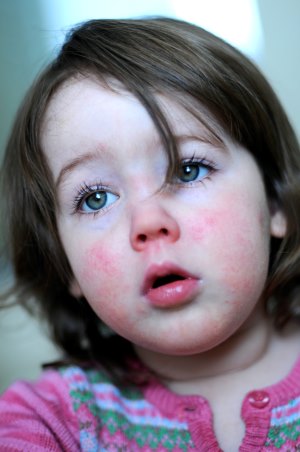
Evaluation
When evaluating a patient suspected of having scarlet fever due to a blanching, maculopapular, sandpaper-like rash, or other compatible physical findings, it is essential to identify the source of their GAS infection. As scarlet fever is most commonly associated with GAS pharyngitis, the use of the CENTOR criteria, combined with laboratory testing, when necessary, can help confirm or rule out this diagnosis. If pharyngitis is excluded, other potential sites of primary GAS infection should be investigated, necessitating a thorough physical examination.
Laboratory testing for GAS pharyngitis involves a throat swab and culture, which remain the gold standard for identifying GAS. GAS is easily cultured on sheep blood agar and is both catalase- and oxidase-negative. Confirmatory identification can be performed using Lancefield grouping or more advanced methods such as the matrix-assisted laser desorption ionization-time of flight (MALDI-TOF). However, culture results typically take 24 hours or longer, which may delay critical decisions related to treatment, isolation, and epidemiological considerations.
A rapid antigen detection test (RADT) can also be used to diagnose GAS pharyngitis. The RADT has a sensitivity of approximately 85% in children, although there is some variability, and its specificity is stable at 95%. If the RADT result is negative, treatment decisions should follow national guidelines. A polymerase chain reaction (PCR) can also identify specific GAS strains, particularly in complicated cases.
Diagnosis
The diagnosis is mostly based on the clinical presentation. However, leukocytosis with left shift presentation and possibly eosinophilia a few weeks after convalescence on a standard blood test and urine tests are part of a complete medical workup. The following studies are indicated in scarlet fever:
- Throat or nasal culture or rapid streptococcal test,
- Anti-deoxyribonuclease B, antistreptolysin-O titers (antibodies to streptococcal extracellular products), antihyaluronidase, and antifibrinolysin can be valuable in confirmation of the diagnosis.
In most cases, no imaging studies are indicated.
Blood Study
The complete blood cell (CBC) count commonly reveals a leukocytosis. The white blood cell (WBC) count in scarlet fever may increase to 12,000-16,000/μL, with a differential of up to 95% polymorphonuclear leukocytes. During the second week, eosinophilia, as high as 20%, can develop.
Urine study
Urinalysis and liver function tests may reveal changes associated with complications of scarlet fever. Said tests are part of a complete medical workup. Hemolytic anemia can occur, and mild albuminuria and hematuria may be present early in the disease. 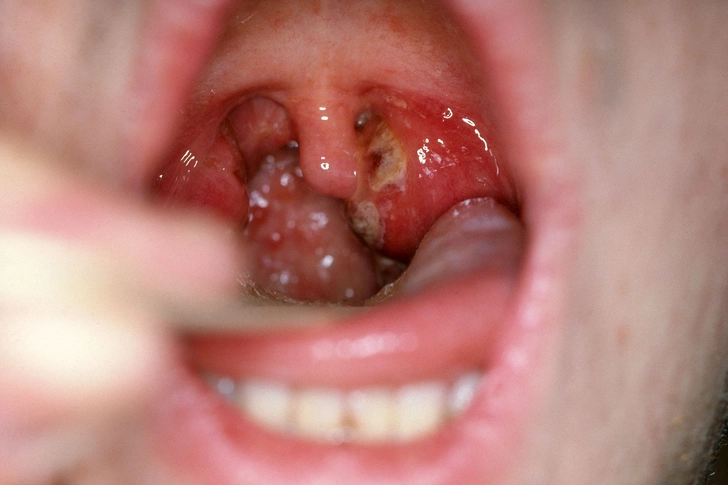
Patients whose bacterial source may suggest another process (eg, a patient with a suppurative leg wound who may have osteomyelitis) should be evaluated accordingly or prevention and treatment of rheumatic fever state that group A streptococci virtually always are found on throat culture during acute infection.
Throat cultures are approximately 90% sensitive for the presence of group A beta-hemolytic streptococci (GABHS) in the pharynx. However, because a 10-15% carriage rate exists among healthy individuals, the presence of GABHS is not proof of disease.
Anti deoxyribonuclease B and Anti streptolysin O Titers
Streptococcal antibody tests (eg, antideoxyribonuclease B [ADB] and antistreptolysin O [ASO] titers) are used to confirm previous group A streptococcal infection. The most commonly available streptococcal antibody test is the ASO test. An increase in ASO titers can sometimes be observed but is a late finding and usually of value only in retrospect.
Streptococcal antibody tests can provide confirmatory evidence of recent infection but have no value in acute infection and currently are not indicated in this setting. They may be of value in patients with suspected acute renal failure or acute glomerulonephritis.
Allopathic treatment / Management
Penicillin remains the first-line allopathic treatment, with alternative/Homeopathic therapies available for individuals with confirmed penicillin allergies. Antibiotic therapy is the treatment of choice for scarlet fever. Whether antibiotics prevent poststreptococcal glomerulonephritis is still debated in the literature.
Scarlet fever can lead to complications such as rheumatic heart disease and glomerulonephritis, so early recognition and treatment are crucial.
The allopathic goals in the treatment of scarlet fever are:
(1) to prevent acute rheumatic fever,
(2) to reduce the spread of infection,
(3) to prevent poststreptococcal glomerulonephritis and suppurative sequelae (eg, adenitis, mastoiditis, ethmoiditis, abscesses, cellulitis),
(4) to shorten the course of illness.
Culture results are crucial for tailoring allopathic antibiotic therapy and ensuring that the initial empirical antibiotic regimen covers GAS, especially in light of reports of penicillin resistance and the increasing resistance of GAS to macrolides and clindamycin. 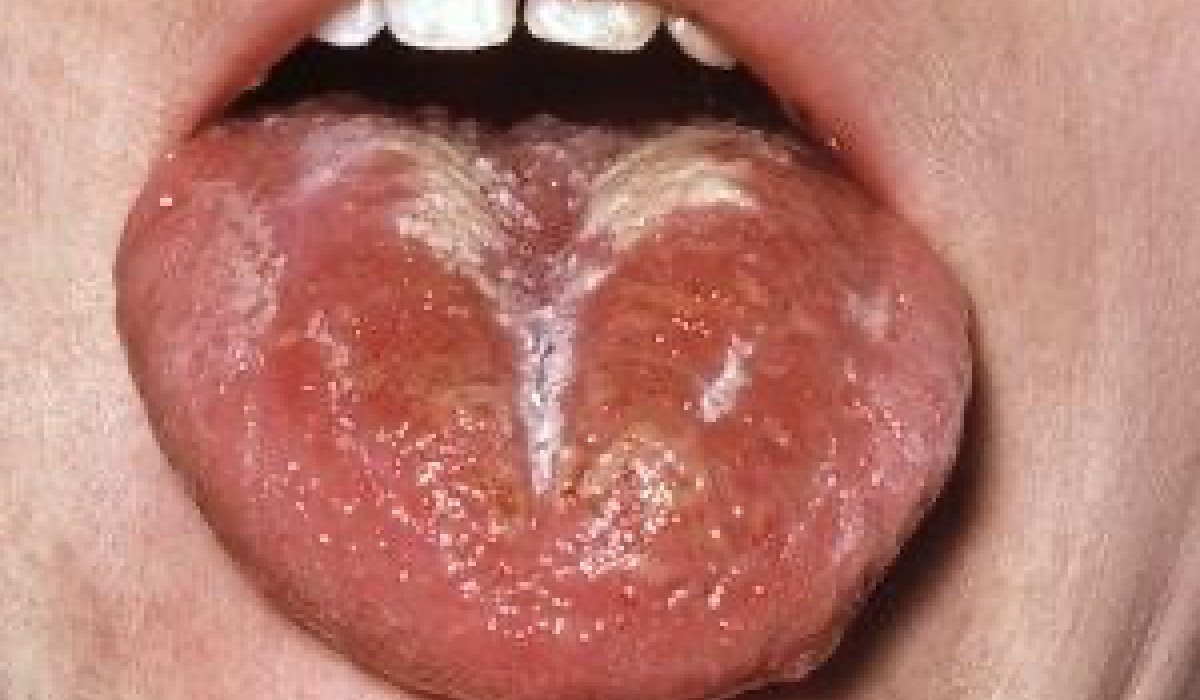
Penicillin (or amoxicillin) remains the drug of choice (documented cases of penicillin-resistant group A streptococcal infections still do not exist). A first-generation cephalosporin may be an effective alternative, as long as the patient does not have any documented anaphylactic reactions to penicillin. If this is the case, clindamycin or erythromycin may be considered as an alternative. However, some strains of group A streptococci may not be susceptible to macrolides. Hence, in this situation, it is crucial to contact the microbiology laboratory with regard to the sensitivity of the organism to macrolide antibiotics. A 10- to 14-day course of treatment is usually recommended, and clinical improvement should be noted after 24-48 hours of antibiotic initiation.
Cultures should be obtained where organisms other than streptococcal bacteria are suspected. The desquamating rash that follows is self-limited, with only emollients necessary for care.
Severe cases
If odynophagia accompanying streptococcal pharyngitis is especially severe, hospitalization may be warranted for intravenous hydration and antibiotics.
β-lactam antibiotics remain consistently effective against GAS and scarlet fever and are the preferred treatment for both noninvasive and iGAS infections. While there have been reports of penicillin resistance and increased minimum inhibitory concentrations to penicillin and cephalosporins, these are primarily attributed to mutations in the peptidoglycan-synthetic enzyme pbp2x gene.
For patients allergic to penicillin, the most notable alternative antibiotics are macrolides (eg, erythromycin) and lincosamides (eg, clindamycin). However, resistance to these antibiotics has increased over the past decade, with variable prevalence of resistant GAS strains observed globally.
Treatment duration
More specifically, when treating GAS pharyngitis and scarlet fever, a 10-day course of oral antibiotics is typically recommended. Recommended regimens include penicillin V or amoxicillin for 10 days, which is administered by mouth.
An alternative treatment for GAS pharyngitis is a single intramuscular dose of penicillin G benzathine, particularly for patients who may not complete the full course of oral antibiotics. Macrolides or clindamycin can be used for patients allergic to penicillin, although local resistance patterns should be considered.
Broad-spectrum antibiotics should be initiated for severe infections caused by GAS, such as necrotizing fasciitis and TSS, to ensure adequate coverage while awaiting final culture results. For severe infections, such as TSST-1 and necrotizing fasciitis, clindamycin is often added to the antibiotic regimen, such as penicillin.
In addition to antibiotics, supportive measures—such as fluid resuscitation and blood pressure management with vasopressors—should also be implemented for these severe or systemic infections.
Homeopathic Treatment for scarlet fever
The symptoms listed against each medicine may not be directly related to this disease because in Homeopathy general symptoms and constitutional indications are taken into account for selecting a remedy.
None of these medicines should be taken without professional advice.
Dr. Qaisar Ahmed. MD, DHMS, Isl. Jurisprudence.
Baryta Carb
Aneurysm. Apoplexy. Atrophy. Brain, affections of. Cysts. Glands around ears painful and swollen. Reverberation on blowing nose. Foot-sweat. Glandular swellings. Hemorrhoids. Heart affections. Memory defective. Esophagus spasm. Paralysis of tongue, smarting burning pain in tip of tongue. Dribbling of saliva. Submaxillary glands and tonsils swollen. Spasm of esophagus. Tonsils inflamed, with swollen veins. Smarting pain when swallowing; worse empty swallowing. Feeling of a plug-in pharynx. Panaras. Paralysis. Parotitis. Prostate enlarged. Quinsy. Throat, sore. Tonsils, enlarged. Tumors. Warts. Wens. Dry, suffocative cough, especially in old people, full of mucus but lacking strength to expectorate. Palpitation and distress in region of heart. Aneurysm.
Agraphis Nutans
Catarrhal conditions; obstruction of nostrils. Adenoids, throat deafness. Enlarged tonsils. Mucous diarrhea from cold. Chill from cold winds. Throat and ear troubles with tendency to free discharge from mucous membranes. Mutinism of childhood unconnected with deafness. Adenoids with enlarged tonsils.
Bacillinum
Addison’s disease. Alopecia. Consumptiveness Growth, defective. Hydrocephalus. Idiocy. Insanity. Joints, affections of. Pityriasis. Pityriasis Ringworm. Scrofulous glands. Teeth, defective; pitted. Tuberculosis.
Calcarea carb
Bronchial glands infections. Consumption. Corpulency. Coryza. Cough. Coxalgia. Croup. Crusta lactea. 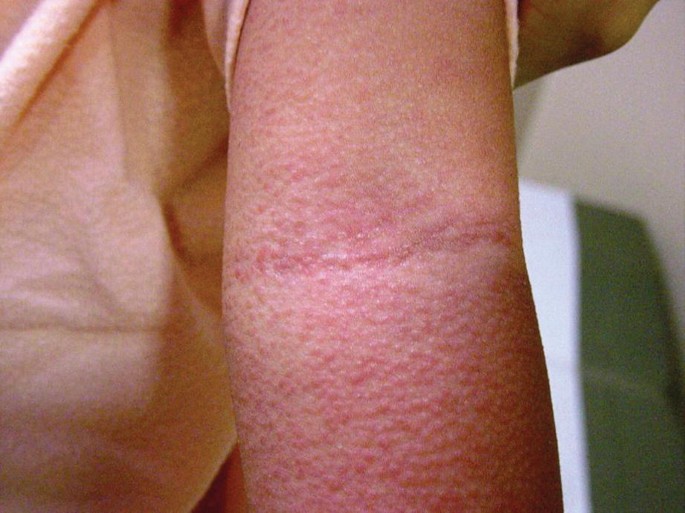 Debility. Ear infections. Submaxillary glands swollen. Swelling of tonsils and submaxillary glands; stitches on swallowing. Hawking-up of mucus. Difficult swallowing. Goiter. Parotid fistula. Extreme dyspnea. Adenoids and tonsillitis. Painless hoarseness. Expectoration only during the day; thick, yellow, sour mucus. Bloody expectoration; with sour sensation in chest. Palpitation with feeling of coldness, with restless oppression of chest. Fever with sweat. Restless sleep.
Debility. Ear infections. Submaxillary glands swollen. Swelling of tonsils and submaxillary glands; stitches on swallowing. Hawking-up of mucus. Difficult swallowing. Goiter. Parotid fistula. Extreme dyspnea. Adenoids and tonsillitis. Painless hoarseness. Expectoration only during the day; thick, yellow, sour mucus. Bloody expectoration; with sour sensation in chest. Palpitation with feeling of coldness, with restless oppression of chest. Fever with sweat. Restless sleep.
Sambucus Canadensis
Pharynx and larynx felt dry and swollen, impeding free respiration. Severe headache. Temperature. Breathing labored, asthmatic; wheezing. Heaviness and constriction in chest. Sharp pain in heart (region of valves) with palpitation. Heart labors heavily. Pulse rose to 100 but became normal at end of perspiration. Exhaustion. Adenoids and tonsillitis. Uneasiness; unrest. Recurrence of symptoms.
Sambucus Nigra
Dry coryza of infants, snuffles, edematous swellings. Profuse sweat accompanies many affections. Angina pectoris. Asthma. Miller’s asthma. Chest oppression, Dyspnea. Coryza dry. Suffocative cough. Croup. Hoarseness with tenacious mucus in larynx. Paroxysmal, suffocative cough. Emaciation. Adenoids and tonsillitis. Hoarseness. Hydrocele. Ileus. Laryngismus. Perspirations. Phthisis. Scurf. “Snuffles.” Starting. Whooping-cough. Temperature. Profuse sweating.
Natrum Mur
Violent, fluent coryza. Stoppage of nose, making breathing difficult. Violent sneezing coryza. Stitches all over chest. Cough, with bursting pain in head. Shortness of breath. Adenoids and tonsillitis. Whooping-cough. Tachycardia. Sensation of coldness of heart. Heart and chest feel constricted. Fluttering, palpitating; intermittent pulse. Heart’s pulsations shake body. temperature: violent thirst, increases with fever. Fever-blisters. Coldness of the body.
The natrum mur child is cranky and stubborn nature.
Opium
Lean and thin, emaciated with enlarged adenoids, snoring, rattling and Sertorius breathing, may have brief pauses in breathing during sleep. The other symptoms are of excessive drowsiness and sleep during the day. Tongue black paralyzed bloody froth. Intense thirst. Blubbering op lips. Difficult articulation and swallowing. Hoarse. Deep snoring; rattling, stertorous breathing. Difficult, intermittent, deep, unequal respiration. Heat in chest; burning about heart. Adenoids and tonsillitis infection. Cough, with dyspnea and blue face; with bloody expectoration. Pulse full and slow. Heat extending over body. Hot perspiration. 
Kali Sulphuricum
Kali Sulphuricum is even best for adenoids that regrow after surgery or remaining after removal of adenoids. Eustachian deafness. Discharge of yellow matter. Cold, with yellow, slimy expectoration. Nose obstructed. Smell lost. Engorgement of the nasal pharyngeal mucous membrane, mouth breathing, snoring. Post-grippe cough. Epithelioma. Intermittent fever, with yellow, slimy tongue. Adenoids and tonsillitis.
Ammonium Carbonicum
Hardness of hearing. Shocks through ears, eyes, and nose, when gnashing teeth. Discharge of sharp, burning water. Stoppage at night, with long continued coryza. Bloody nasal mucus. Enlarged tonsils and glands of neck. Adenoids and tonsillitis. Burning pain all down throat. Tendency to gangrenous ulceration of tonsils. Diphtheria when nose is stopped up. Chest feels tired. Emphysema. Oppression in breathing. Pneumonia. Slow labored, stertorous breathing; bubbling sound with slimy sputum and specks of blood. Pulmonary oedema.
Audible cardiac palpitation with fear, cold sweat, lachrymation, inability to speak, loud breathing and trembling hands. Heart weak, wakes with difficult breathing and palpitation.
Mercurius Dulcis
Excessive ulceration of throat. Difficulty of swallowing. Scrofulous otitis. Otitis media; closure of Eustachian tube; ear troubles of scrofulous children; membranes tympani retracted, thickened and immovable. Constant flow of dark, putrid saliva; very offensive. Adenoids and tonsillitis. Ulceration of throat, with dysphagia. Granular pharyngitis.
Mercurius Solubilis
Bluish-red swelling. Constant desire to swallow. Putrid sore throat; worse right side. Ulcers and inflammation appearing at every change in weather. Stitches into ear on swallowing; fluids return through nose. Quinsy, with difficulty swallowing, after pus has formed. Adenoids and tonsillitis – sore, raw, smarting, burning throat. Complete loss of voice. Burning in throat, as from hot vapor ascending. Otalgia. Coryza. Severe temperature. Night sweating.
China Officinalis
Aphthae. Apoplexy Appetite, disordered. Asthma. Cough. Debility. Deafness. Tinnitus. Hearing sensitive to noise. Lobules red and swollen. Coryza, sneezing, watery discharge. Violent dry sneezing. Influenza, with debility. Adenoids and tonsillitis infections. Labored slow respiration, constant choking. Suffocative catarrh. Hemorrhage from lungs. Dyspnea, sharp pain in left lung. Heart irregular with weak rapid beats followed by strong, hard beats. Suffocative attacks, syncope; anemia and dropsy. Severe temperature. Debilitating night-sweats.
Tuberculinum
Asthma. Bones, caries of. Bronchitis. Catarrhal pneumonia. Chilblains. Heart infections. Cardiac palpitation. Influenza. Lupus. Edema glottidis. Phthisis. Pleurisy. Acute pneumonia. Offensive otorrhea. Perforation in membrane tympani. Adenoids and tonsillitis. Hard, dry cough during sleep. Expectoration thick, easy; profuse bronchorrhea. Shortness of breath. Sensation of suffocation. Hard hacking cough. Profuse sweating. Post-critical temperature.
Pyrogenium
Diphtheria with extreme fetor. Cough; with large masses of phlegm. Cough with night-sweats and frequent pulse. Cardiac asthenia from septic conditions. Throat dry, articulation difficult.
Psorinum
Adenoids and tonsillitis infection. Diphtheria. Influenza. Otorrhea. Dry, coryza, with stoppage of nose. Tonsils greatly swollen; painful swallowing, with pain in ears. Profuse, offensive saliva; tough mucus in throat. Recurring quinsy. Eradicates tendency to quinsy. Hawking up of cheesy, pea-like balls of disgusting smell and taste. Asthma with dyspnea. Dry hard cough. Profuse, offensive perspiration; night-sweats. 
Agaricus Muscarious
Dry fauces and pharynx, causing contraction and difficulty of swallowing. Stitches along eustachian tube to ear. Feels contracted. Small solid balls of phlegm thrown up. Dryness of pharynx, swallowing difficult. Scratching in throat. Induration of tonsils. Heart irregular, tumultuous palpitation. Painful palpitations of the heart. Spasmodic cough. Adenoids and tonsillitis infections.
Dr. Qaisar Ahmed’s advice: In infection always advise highly diluted potencies.
Tips for enlarged adenoids and tonsillitis:
- The most effective remedy for enlarged adenoids is gargling warm saline water. Warm water has a soothing effect on the sore throat, the salt help to relieve pain.
- For children with adenitis give them as much hot fluid (and soups etc) as possible. These beverages will not only provide them with appropriate nutrition but will also provide relief from pain.
- Drinking warm water with a bit of honey and lemon juice will work fine as well.
- Steam inhalation is also beneficial with enlarged adenoids that helps to relieve the blocked nose caused by swollen adenoid, which commonly leads to snoring or noisy breathing.
- Turmeric is very helpful for enlarged adenoids. take a glass of warm milk and add a little black pepper and turmeric powder in it and give this to your child at bedtime.
- Take 10 leaves of basil and add them to one and a half cup of water and boil it for 15 minutes and give it to your child two times daily. It is very helpful for allergic cold, cough, tonsillitis and adenoids.
- Encourage your child to drink lots of fluids in chronic tonsillitis and adenoids because a good hydration level is needed for the immune system to work properly. It is suggested to give 8 glasses of water every day and in addition to water, you can also give other beverages such as fresh fruit juice, clear soups, herbal teas and warm broth.
P. S: This article is only for doctors and students having good knowledge about Homeopathy and allopathy.

For proper consultation and treatment, please visit our clinic.
 Dr. Sayyad Qaisar Ahmed (MD {Ukraine}, DHMS), Abdominal Surgeries, Oncological surgeries, Gastroenterologist, Specialist Homeopathic Medicines.
Dr. Sayyad Qaisar Ahmed (MD {Ukraine}, DHMS), Abdominal Surgeries, Oncological surgeries, Gastroenterologist, Specialist Homeopathic Medicines.
Senior research officer at Dnepropetrovsk state medical academy Ukraine.
Location: Al-Haytham clinic, Umer Farooq Chowk Risalpur Sadder (0923631023, 03119884588), K.P.K, Pakistan.
Find more about Dr Sayed Qaisar Ahmed at:
https://www.youtube.com/Dr Qaisar Ahmed
